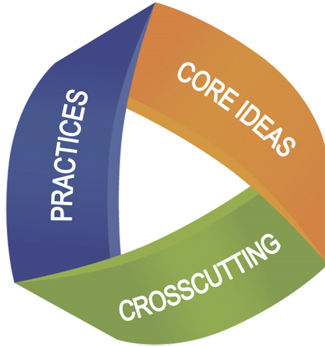You are here
Three Dimensional (3-D) Learning

The National Research Council's (NRC) Framework describes a vision of what it means to be proficient in science; it rests on a view of science as both a body of knowledge and an evidence-based, model and theory building enterprise that continually extends, refines, and revises knowledge. Read more about the three dimensions in the NRC Framework online here. The CAS Science Standards are three-dimensional standards, organized by Prepared Graduate Statement and Grade Level Expectations. On each standards page, educators will note Evidence Outcomes (EO's) that are comprised of a Science and Engineering Practice (SEP), the grade level expectation and elaboration on the grade-level expectation (GLE), and a Crosscutting Concept. Standards pages might have one or more three-dimensional evidence outcomes. Learn more about the three-dimensions in the sections below.
Dimension 1: Science and Engineering Practices
The practices describe behaviors that scientists engage in as they investigate and build models and theories about the natural world and the key set of engineering practices that engineers use as they design and build models and systems. The NRC uses the term practices instead of a term like “skills” to emphasize that engaging in scientific investigation requires not only skill but also the knowledge that is specific to each practice. Part of the NRC’s intent is to better explain and extend what is meant by “inquiry” in science and the range of cognitive, social, and physical practices that it requires.
Although engineering design is similar to scientific inquiry, there are significant differences. For example, scientific inquiry involves the formulation of a question that can be answered through investigation, while engineering design involves the formulation of a problem that can be solved through design. Strengthening instruction involving engineering will clarify for students the relevance of science, technology, engineering, and mathematics (the four STEM fields) to everyday life.
Tools and Resources
- Review the grade band progressions connected with the standards in the Colorado Science and Engineering Practices Learning Progressions Resource
- Read about the Science and Engineering Practices in the Framework for K-12 Science Education
- Watch a video to learn more: Science and Engineering Practices Explainer Video - Bozeman Science
Dimension 2: Crosscutting Concepts
Crosscutting concepts have application across all domains of science. As such, they are a way of linking the different domains of science. They include the following: Patterns; Cause and Effect; Scale, Proportion, and Quantity; Systems and System Models; Energy and Matter; Structure and Function; and Stability and Change. The Framework emphasizes that these concepts need to be made explicit for students because they provide an organizational schema for interrelating knowledge from various science fields into a coherent and scientifically-based view of the world.
Tools and Resources
- Review the grade band progressions connected with the standards in the CDE Crosscutting Concepts Progressions Resource
- Read about the Crosscutting Concepts in the Framework for K-12 Science Education
- Watch a video to learn more: Crosscutting Concepts Video Resource -Bozeman Science
Dimension 3: Disciplinary Core Ideas
For the Colorado Academic Standards, disciplinary core ideas are represented by our Grade Level Expectations (GLE's). GLE's are arranged in the CAS by science domain and Prepared Graduate Statement (PG). Disciplinary core ideas have the power to focus K–12 science curriculum, instruction, and assessments on the most important aspects of science. To be considered core, the ideas should meet at least two of the following criteria and ideally all four:
- Have broad importance across multiple sciences or engineering disciplines or be a key organizing concept of a single discipline;
- Provide a key tool for understanding or investigating more complex ideas and solving problems;
- Relate to the interests and life experiences of students or be connected to societal or personal concerns that require scientific or technological knowledge;
- Be teachable and learnable over multiple grades at increasing levels of depth and sophistication.
Tools and Resources
- Review the grade band progressions connected with the standards in the CDE Grade Level Expectations Progressions Resource (Organized by science discipline and prepared graduate statement)
- Read about the science domains: the physical sciences; the life sciences; and the earth and space sciences in the Framework for K-12 Science Education
- Watch a video to learn more about: Disciplinary Core Ideas -Bozeman Science (scroll down to view topics organized by science domain)
- General Information
- Storylines
- Three-Dimensional Assessment
- Driving Question Board
- Student Talk
For further assistance, please contact:


Connect With Us





